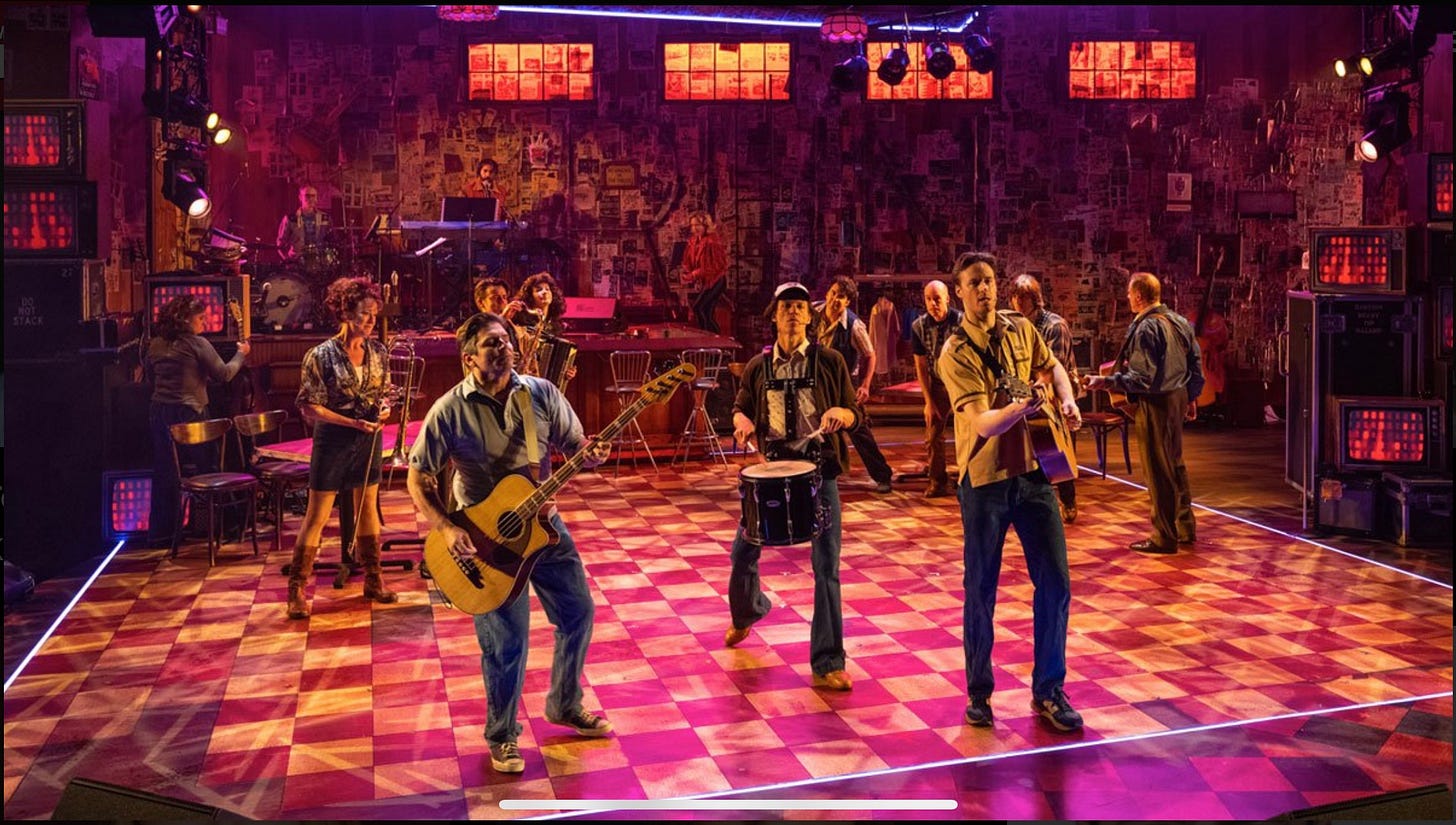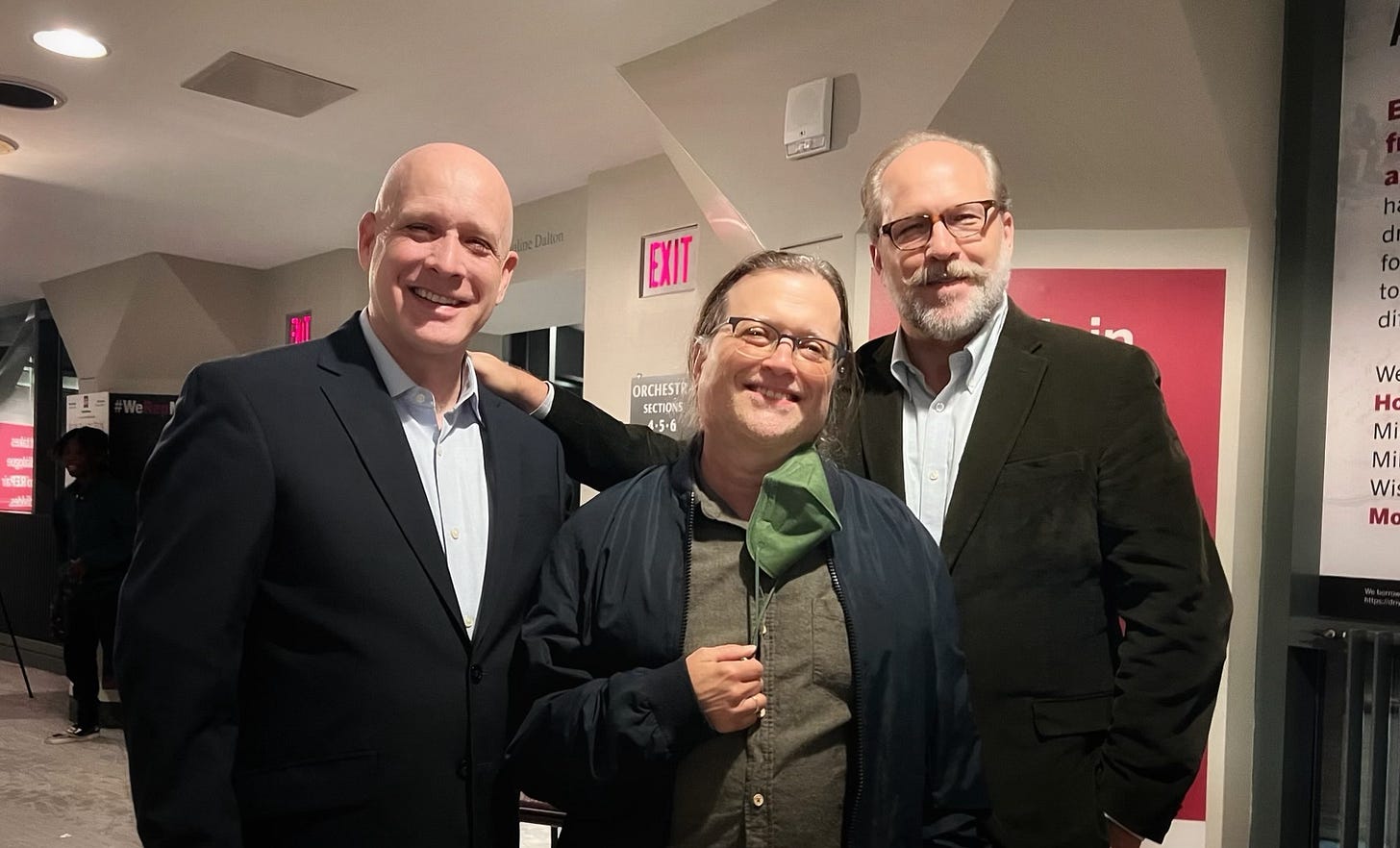Gone, Bambi, Gone!
Gordon Gano, the Founder of The Violent Femmes, Has Written "Run, Bambi, Run," His First Musical, With Bookwriter Eric Simonson. It Is Now Playing at Milwaukee Rep.
If you lived in Milwaukee in the early 1980s, you couldn’t escape two very big, very different news stories. The first was about the sensational, headline-grabbing trial of Laurencia “Bambi” Bambenek, a former Milwaukee cop and Playboy bunny who was accused of murdering her policeman husband’s ex-wife. The second was about the rise of the Milwaukee-born rock trio The Violent Femmes, led by singer-songwriter Gordon Gano. Their self-titled debut album was an alt rock phenomenon. Several of its songs, like “Blister in the Sun,” “Gone, Daddy, Gone,” “Kiss Off” and “Add It Up,” became classic anthems of teenage angst.
Actually, you didn’t have to live in Milwaukee—or even Wisconsin for that matter—to have heard of those two tales. Because Bambenek’s three-ring-circus of a trial made national headlines. So did the music of The Violent Femmes, who went on to become the most famous and lauded rock band that Milwaukee has ever produced.
Now, forty years later, those two stories have improbably collided in the form of Run, Bambi, Run, a new musical that chronicles the life of Bambenek, which is at turns chaotic, tragic and hilarious in its sheer absurdity. The show—which we attended last Saturday—began previews at Milwaukee Repertory Theater on Sept. 15 and will open this Friday.
The music and lyrics are by Gordon Gano, whose is making his first foray into musical theater with this show. The book is by Eric Simonson, who has my same surname. I won’t say “no relations,” because Eric is absolutely a relation. He’s my brother. Eric is a multi-hyphenate performing arts professional, having directed and written many dozens of plays, musicals, operas, films and television programs. He is a member of Chicago’s Steppenwolf Theater Company and has acted, directed and written for Broadway. He’s even won an Oscar. (Google it.) The show is directed by Milwaukee Rep’s longtime artistic director Mark Clements.
Gano and Simonson had their hands full telling the Laurie Bambenek story. Let’s just say that if they had written her history from scratch as fiction, if would have been dismissed as unbelievable. Bambenek’s journey of misadventure and woe had as many twists and turns as the downtown Milwaukee freeway system (which locals used to call the “can of worms”).
She joined the Milwaukee Police Force in 1980 at a time when female recruits were few and the department was still under the iron-fisted control of Harold Breier, whose 20-year reign as police chief (1964-1984) was marked by racism, sexism and charges of police brutality. She was dismissed from the force within a month, on the flimsiest of premises. (Breier was known to draft female and minority officers in order to meet guidelines for federal funding, only to find ways to force them out almost immediately.) Needing to work, Bambenek—who was 5’10”, blonde and strikingly beautiful—soon became a bunny at the Playboy Club in Lake Geneva, Wisconsin.
Bambemek had a pending discrimination suit against the MPD when she married Elfred “Fred” Schultz, a 13-year vet of the department. Schultz was known as “Disco Fred” and had appeared nude in an Adonis competition held annually among Milwaukee cops in a city park. While with Laurie, Fred was known to complain about the crippling alimony he had to pay to his ex-wife, Christine Schultz, with whom he had two children.
The circumstantial case that put Bambenek behind bars for the murder of Fred’s ex-wife, Christine, included: an alleged green track suit: a red wig found flushed down the toilet: a drug-dealing, bodybuilder roommate; Schultz’s off-duty revolver, which may or may not have been used that night; a conveniently lost policeman’s notebook; and the damning testimony of her erstwhile best friend, another former female cop. (The friend, who was dating the bodybuilder—and later dates (and was robbed!) by another suspect in the murder—later recanted).
The trial was rich is strange characters, all of whom seemed to know each other. (It’s not called “Small-waukee” for nothing.) It was also the first start-to-finish televised trial in the state of Wisconsin, and avidly watched. Everyone in Milwaukee had an opinion and took sides.
Bambenek maintained her innocence all along. But after three unsuccessful appeals, she decided to break out of the Taycheedah Correctional Institution in 1990, with the help of Dominic Gugliatto, the brother of her cellmate. They went on the lam, fleeing to Thunder Bay, Canada, where she worked as a waitress. She was soon caught, with the help of a snitching viewer of “America’s Most Wanted,” and remanded to a Canadian prison. She sought refugee status and won the right to a new trial in Milwaukee. But, rather than risk a second guilty verdict, she accepted a plea deal of no contest to second-degree murder and was sentenced to time served.
It was at this time that she became a cause célèbre, with the cry of “Run, Bambi, Run!” ringing out across the world, and printed on t-shirts. Bambenek’s cause was helped by the fact that the MPD was then dealing with the blowback of its mishandling of the Jeffrey Dahmer case, and was now being eyed by the press and public with new suspicion. In retrospect, the MPD’s case against Bambenek looked increasingly like a frame-up to many observers.
The Bambenek story has had a long shelf life, primarily because it is so confusing, and has never been satisfactorily understood or resolved. Bambenek was played by actresses Lindsay Frost and Tatum O’Neal in separate made-for-TV movies. The trial has been the subject of multiple books. And last year it was the subject of an eight-part podcast produced by Campside Media.
Gano and Simonson tell this story through more than 30 songs stretched over nearly three hours. The cast all essay multiple roles, and are part of the band, playing various instrument at various times. The set is meant to mimic Tracks, a tavern on Milwaukee’s north side that was known as a cop hangout.
“Working with Gordon has been the best and most rewarding collaboration of my career,” Simonson told The Mix. “In the medium of musical theatre, he’s a natural.”
A couple weeks ago, I had the chance to talk to Gano about Run, Bambi, Run. That conversation, edited for space and clarity, is below.
THE MIX: How did this project come about?
GORDON GANO: Well, your brother [laughs]. I got a call one day. At that time I was living in New York City. A phone was ringing and it was a landline, and I almost never picked it up, but I thought, “Ugh, I’ll pick it up.” It was Eric and Mark Clements, the artistic director of the Milwaukee Rep, and they were both on the line trying to get ahold of me… That’s how it happened. I even thought after we had the conversation, “I’m so glad I picked up the phone.” What a nice thing, just to be asked about this project and if I was interested, which I was. And from the early conversations, I was interested in writing all-new music for [the show], as opposed to being, “Where’s the best place to put ‘Blister in the Sun.’” or something like that. I was really excited about all new things written specifically for a story… This was some years ago.
The Mix: Yes, this project was almost ten years in the making, wasn’t it?
GG: Yes, yes.
The Mix: What did you think of the idea of the musical, telling the story of Laurie Bambenek?
GG: I didn’t have that much of a reaction other than I knew of it. When it was happening, I wasn’t following it in any kind of way. I think that’s mostly because, at the time, we were getting Violent Femmes, the band, going. We were getting in a van and playing every little punk rock club in cities all across the country. And whenever we got back to Milwaukee, it wasn’t too long before we got out and did it again. So, I think the first time I saw it in the newspapers, the story had been going on for some time. And then I was traveling again. And this was before Cable and 24-hour news and all of those things. I never had followed it, which also means I didn’t have an opinion about it and I didn’t know a lot about it. So I went into it very fresh. Which I think was perfectly fine.
The Mix: What would say the difference is between a song you wrote for this show and a song you might write for The Violent Femmes?
GG: Well, that’s a great question. Even with the Femmes, I’ve never written songs thinking, “This is going to be for the Violent Femmes.” Because I’ve written more songs than I’ve ever recorded. Most often, the process is: here’s some songs; and if there’s not a positive response [from the band] in wanting to play those songs, those songs sometimes get set aside. Or sometimes we’ll come back years later and we’ll do them. But, certainly I have that in my mind [when I write a song]; a little bit, like, “Well, this could be good for the band.”
But this is so different. To give you an example, there’s one time I wrote something, and I thought, “This is really beautiful. This is, to me, a good song that’s going to have something to say. Even taken out of the context of the show.” And then, I realized, this character would not say this! This character, at this point or maybe ever, they wouldn’t say this. I just wanted them to say it because I think it makes it such a good song. So, I had to rewrite it. It had to be changed, because it didn’t have that true, authentic ring…
Being set in Milwaukee, at some point there had to be a polka. So, it just seemed that, when these people are arguing, and it’s getting so intense, it had to be a polka. There’s an “argument polka.” And I called it the “Argument Polka.” Everytime I hear it, I have to smile or outright laugh.
That’s another thing with the music. The things that I wrote were because I was enjoying writing it. Even if it was expressing something tragic or angry. There’s still some quality to it that I enjoy. It gives me some kind of pleasure, because I’m liking the way this is coming together with the words and the music. I hope people, when they hear it, they will have a similar kind of reaction.
I enjoy writing something that has something serious, but also something that’s humorous at the same time. I feel I get that from Eric as well. He says, he tells groups that are doing his stuff that he laughs more at his own stuff than any audience does. And it’s possible I’m the same way with my songs. I had someone many years ago tell me, “Oh, love your band, love your music, love your songwriting, but can I give you one little tiny piece of advice? You’re so good, but what would just put it over just a little more would be if you wrote with a little bit of humor.” And I just thought, “Wow, you don’t hear any humor in any of these songs you say you love?”
The Mix: That’s crazy. There’s lots of humor in your songs!
GG: Exactly! “OK, thank you. Bye!” Anyway, there’s a lot of humor in the book of this musical, and also in the songs.
The Mix: Were you called upon at any point to give advice to the performers on how to best perform your songs?
GG: Oh, thankfully, no! No.
The Mix: Have you been to rehearsals?
GG: Yes. And I’ve been to some workshops. And I’ve done some Zoom and I’ll do some more Zoom. I think it’s been working out really well… It’s being promoted as a “rock musical” or “new rock musical.” I wasn’t asked about that and I can see the point of it. But there is so much variety in the music. We mentioned the polka. There’s a mazurka. The woman is speaking of her heritage, Polish-American, and where she grew up on the south side of Milwaukee in the Polish neighborhood. I lived with my family for a year or two on the south side and our landlady spoke almost no English and all Polish. There’s a park nearby which makes its way into one of the songs.
The Mix: Kosciuszko Park. We have a bridge in New York named after that Polish military leader and Revolutionary War hero. No one knows how to say the name correctly.
GG: I was carefully not saying the name, because that’s part of the song. It gets said several different ways and there’s a song where people are correcting each other.
The Mix: During this process, have you encountered people who remembered the Bambemek story and offered their opinions on it?
GG: Mostly, no. Because I’m not in Milwaukee. Though I know it made international news. My oldest sister lives in France in a small village. And she and her husband will go to the flea markets. And she saw a book and instead of “Run, Bambi, Run,” it was “Fuis, Bambi, Fuis.” [Laughs] She just happened to see that. So she read all about it in French. But people from Milwaukee who remember from that time have such strong feelings and thoughts about it. There was one person I was talking to who I would say would be on the liberal view of most things. So I mentioned I was working on this musical and they were like, “She is SO guilty,” and I was surprised. You could see he was passionate about it, even after decades.
The Mix: After working on the show, what’s your opinion? Was Bambemek guilty or innocent, or something in between?
GG: I don’t really think about it. Mostly, no. Eric has spoken of this, too. We will never know everything of what really happened. One thing that I’ve gotten [about the story] is that, certain things [about the case], you raise an eyebrow. That just doesn’t seem right. Then, the second eyebrow. Then, I need another eyebrow! I mean, really? This!? And then, really? That!? And that doesn’t seem to ever end. It seems that something was really rotten, or a lot of stuff was rotten. Now, I also haven’t done all my personal research of everything. I wasn’t doing all the reading. I was taking what had been chosen and decided from Eric to present the story. But, definitely, things were messed up.
The Mix: Will the songs for this show be recorded as an album?
GG: It’s almost hard for me to think they wouldn’t be. I just think, and Eric does, that this is going to find a life. And it should. We both feel there is something here of real quality. But I would think there would have to be a recording.
Odds and Ends…
Ron Zeller, the Milwaukee bar owner who bartended at Bryant’s Cocktail Lounge and then, in 1964, opened Bryant’s chief competition, the bar At Random, died on Sept. 7. He was 92. Both bars he was associated with still stand… The Bundy Museum, the multi-armed cultural center in Binghamton, New York, announced it is financial dire straits and may close its doors by the end of the year. The Museum lost a major donor and, shockingly, receives no financial help from the City of Binghamton. It is housed in the former home of Harlow Bundy, an inventor of time clocks whose company evolved into IBM. Among the features found in the complex are a former, intact 1930s barber shop once used by IBM employees in nearby Endicott; a former Binghamton saloon; a collection of antique time clocks; and the world’s only museum dedicated to “The Twilight Zone” inventor Rod Serling, who was raised in Binghamton. The Bundy also hosts film screenings and music events… Negroni Week runs through Sept. 24. Check you favorite local cocktail bar for this years Negroni variations!… Irish Exit, the new transit-hub bar chain concept from the folks at Dead Rabbit, opened in Moynihan Train Hall at Penn Station in New York this week… Days of Wine and Roses, the musical version of the movie of the same name, which played a run Off-Broadway earlier this year at the Atlantic Theater Company, will move to Broadway on Jan. 6… The classic Paris Theater, the last single-screen movie theater left in Manhattan, was reopened recently by Netflix with a film series titled “Big and Loud.”… Greenwood Supper Club in Door County, which opened in the 1920s, is no longer serving food and is open only as a bar.












I love this for so many reasons! It’s a great show. And a fun interview -- I am a big fan of Eric --and Gordon’s (ever since freshman year at NU when a guy named John played the VF’s first album over and over again) 👏👏👏
I had NO idea that Eric wrote the book for this show! That absolutely makes sense - a strong match of writer to subject. 🎉